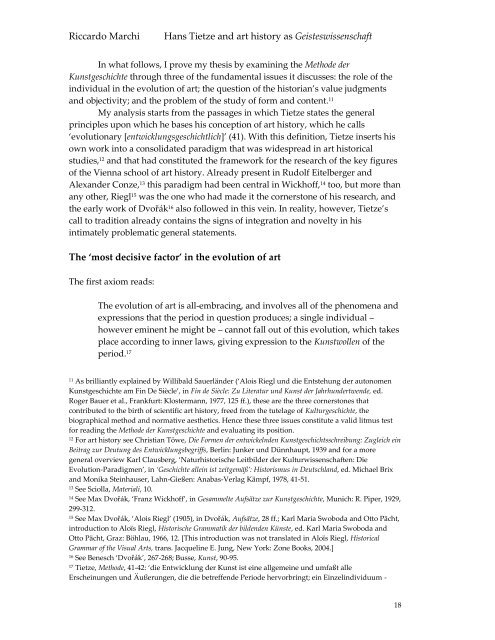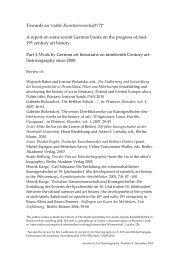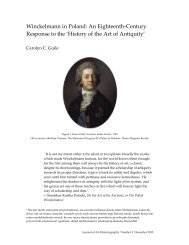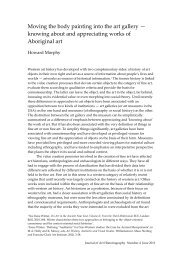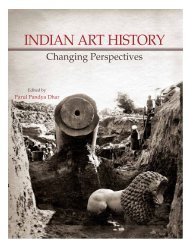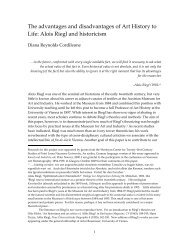Geisteswissenschaft - Journal of Art Historiography
Geisteswissenschaft - Journal of Art Historiography
Geisteswissenschaft - Journal of Art Historiography
Create successful ePaper yourself
Turn your PDF publications into a flip-book with our unique Google optimized e-Paper software.
Riccardo Marchi Hans Tietze and art history as <strong>Geisteswissenschaft</strong><br />
In what follows, I prove my thesis by examining the Methode der<br />
Kunstgeschichte through three <strong>of</strong> the fundamental issues it discusses: the role <strong>of</strong> the<br />
individual in the evolution <strong>of</strong> art; the question <strong>of</strong> the historian’s value judgments<br />
and objectivity; and the problem <strong>of</strong> the study <strong>of</strong> form and content. 11<br />
My analysis starts from the passages in which Tietze states the general<br />
principles upon which he bases his conception <strong>of</strong> art history, which he calls<br />
‘evolutionary [entwicklungsgeschichtlich]’ (41). With this definition, Tietze inserts his<br />
own work into a consolidated paradigm that was widespread in art historical<br />
studies, 12 and that had constituted the framework for the research <strong>of</strong> the key figures<br />
<strong>of</strong> the Vienna school <strong>of</strong> art history. Already present in Rudolf Eitelberger and<br />
Alexander Conze, 13 this paradigm had been central in Wickh<strong>of</strong>f, 14 too, but more than<br />
any other, Riegl 15 was the one who had made it the cornerstone <strong>of</strong> his research, and<br />
the early work <strong>of</strong> Dvořák 16 also followed in this vein. In reality, however, Tietze’s<br />
call to tradition already contains the signs <strong>of</strong> integration and novelty in his<br />
intimately problematic general statements.<br />
The ‘most decisive factor’ in the evolution <strong>of</strong> art<br />
The first axiom reads:<br />
The evolution <strong>of</strong> art is all-embracing, and involves all <strong>of</strong> the phenomena and<br />
expressions that the period in question produces; a single individual –<br />
however eminent he might be – cannot fall out <strong>of</strong> this evolution, which takes<br />
place according to inner laws, giving expression to the Kunstwollen <strong>of</strong> the<br />
period. 17<br />
11 As brilliantly explained by Willibald Sauerländer (‘Alois Riegl und die Entstehung der autonomen<br />
Kunstgeschichte am Fin De Siècle’, in Fin de Siècle: Zu Literatur und Kunst der Jahrhundertwende, ed.<br />
Roger Bauer et al., Frankfurt: Klostermann, 1977, 125 ff.), these are the three cornerstones that<br />
contributed to the birth <strong>of</strong> scientific art history, freed from the tutelage <strong>of</strong> Kulturgeschichte, the<br />
biographical method and normative aesthetics. Hence these three issues constitute a valid litmus test<br />
for reading the Methode der Kunstgeschichte and evaluating its position.<br />
12 For art history see Christian Töwe, Die Formen der entwickelnden Kunstgeschichtsschreibung: Zugleich ein<br />
Beitrag zur Deutung des Entwicklungsbegriffs, Berlin: Junker und Dünnhaupt, 1939 and for a more<br />
general overview Karl Clausberg, ‘Naturhistorische Leitbilder der Kulturwissenschaften: Die<br />
Evolution-Paradigmen’, in ‘Geschichte allein ist zeitgemäß’: Historismus in Deutschland, ed. Michael Brix<br />
and Monika Steinhauser, Lahn-Gießen: Anabas-Verlag Kämpf, 1978, 41-51.<br />
13 See Sciolla, Materiali, 10.<br />
14 See Max Dvořák, ‘Franz Wickh<strong>of</strong>f’, in Gesammelte Aufsätze zur Kunstgeschichte, Munich: R. Piper, 1929,<br />
299-312.<br />
15 See Max Dvořák, ‘Alois Riegl’ (1905), in Dvořák, Aufsätze, 28 ff.; Karl Maria Swoboda and Otto Pächt,<br />
introduction to Aloïs Riegl, Historische Grammatik der bildenden Künste, ed. Karl Maria Swoboda and<br />
Otto Pächt, Graz: Böhlau, 1966, 12. [This introduction was not translated in Aloïs Riegl, Historical<br />
Grammar <strong>of</strong> the Visual <strong>Art</strong>s, trans. Jacqueline E. Jung, New York: Zone Books, 2004.]<br />
16 See Benesch ‘Dvořák’, 267-268; Busse, Kunst, 90-95.<br />
17 Tietze, Methode, 41-42: ‘die Entwicklung der Kunst ist eine allgemeine und umfaßt alle<br />
Erscheinungen und Äußerungen, die die betreffende Periode hervorbringt; ein Einzelindividuum -<br />
18


